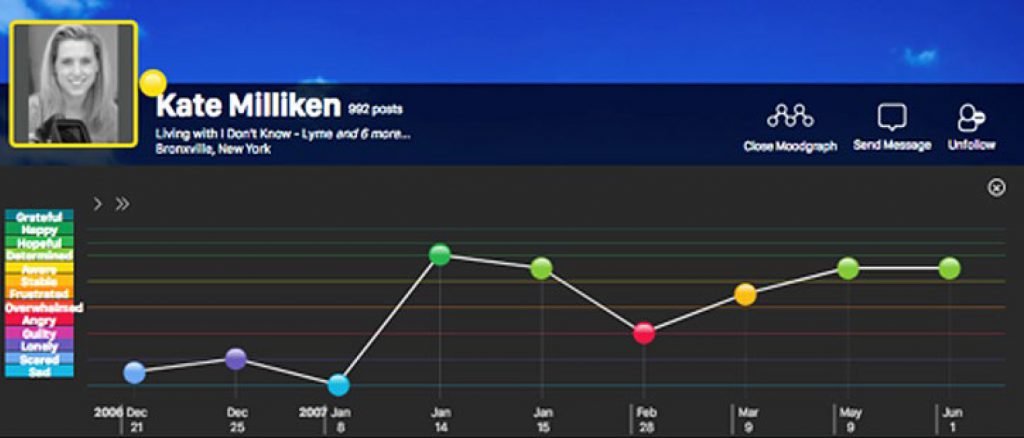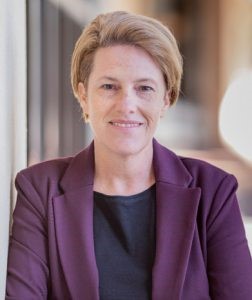Moodify: Improving patients’ lives through unexpected technology
Video journaling is improving the lives of chronic illness patients
Guest blog by Susanne Lake
In 2006 when Kate Milliken was diagnosed with multiple sclerosis, she longed for a connection with others that could relate. She struggled to find online content that came from the patient’s perspective. Being a video producer by trade, Kate decided to create her own content and capture her first year of living with MS in an online video journal. Kate poured her heart into short videos segments which represent her emotional and mental state at various points throughout the year. She laid out the video clips like a patchwork quilt, one piece leading to the next in her personal journey. The result was a very raw, unfiltered and deeply insightful glimpse into her world.
The website, called Kate’s Counterpane (www.katescounterpane.com) had an impact no one expected. Without having any of the videos published on platforms such as YouTube or Vimeo, the site has received 75,000 unique visitors through organic searches since it launched. The visitors were captivated and 65% watched all 40 minutes of video footage. This level of engagement is unheard of and it was clear there was a need for others to also find relatable moments in dealing with chronic illnesses.
Kate empowered 4,500 others to use video journaling as a tool.
Inspired by the success of Kate’s Counterpane, Kate created a platform that allowed people to share their own firsthand moments with chronic illness. In 2013, she launched MyCounterpane (www.mycounterpane.com, currently offline) which drew in people that were searching for support while coming to terms with their diagnosis. Despite the many qualifying questions required to join, the site gained 4,500 registered users, who were primarily people diagnosed with MS or mental health issues. This online community produced an astonishing 35,000 pieces of content. The subscriber base on average spent over 10 minutes a day for a period of two years, earning a higher engagement rate than Facebook. It became not only an outlet for the subscribers but a critical peer to peer support system.
Beyond the remarkable statistics of engagement, Kate wanted to show the platform could be effective in improving the patient’s quality of life. She conducted a participant study with the John Hopkins University that showed the site raised the sense of life purpose which has proven to have health benefits. Even more importantly, participants said they had less suicidal thoughts after using MyCounterpane.
 Additionally, Kate sent 2,500 video entries to the MIT Media lab to analyze emotional intelligence through facial recognition. MIT Media Lab is working towards quantifying pain simply by the way people work to express it. This knowledge could help drive a physician’s awareness to the behavior health of their patients and allow prescriptions to be more integrated between physical and mental health solutions. Through the studies they found there were direct correlations between activities the patient were engaged in and their current emotional state. For instance, if someone was happy but tired, they often were engaged in family activities versus someone who is overwhelmed and tired typically was spending more time in doctor appointments.
Additionally, Kate sent 2,500 video entries to the MIT Media lab to analyze emotional intelligence through facial recognition. MIT Media Lab is working towards quantifying pain simply by the way people work to express it. This knowledge could help drive a physician’s awareness to the behavior health of their patients and allow prescriptions to be more integrated between physical and mental health solutions. Through the studies they found there were direct correlations between activities the patient were engaged in and their current emotional state. For instance, if someone was happy but tired, they often were engaged in family activities versus someone who is overwhelmed and tired typically was spending more time in doctor appointments.
MyCounterpane served as a proof of concept that a community that supports vulnerable states could provide understanding and healing powers. Kate took MyCounterpane offline to figure out how to create the sustaining revenue needed to support a community long term. She has actively been looking for existing communities that the technology could plug into and provide the same impact.
MyCounterpane has been since re-branded as Moodify. The application has the ability to track emotional responses to every stage of an illness. The users have options to write a journal entry, add a picture or create a video about what they are currently experiencing. The application allows subscribers to visually see their journey by capturing a self-rated emotion with each entry. The entries can be searchable so that others can find a moment they can connect to. It’s a connection of shared vulnerability that allows users to heal each other through the story of them.

On the back end, administrators have a dashboard and data can be extracted for insights, such as looking for trends in fatigue. This allows the use cases for the technology to be endless. It could easily plug into hospital systems to improve doctor/patient communication, be a tool for academic medical centers to relate behavioral health to physical health or determine the emotional effects during a clinical trial.
When asked for how she would like to harness the power of Moodify, Kate says, “I really wish healthcare and hospitals were cool enough that when you have that lonely moment of diagnosis, they could take a piece of paper and they could say I know I’ve just diagnosed you with something horrible but I want you to go to Moodify and I want you to find someone that makes you feel better. The idea of this being prescriptive and offering this way for patients and their families to be proactive would be healing.”
I asked Kathy Hoffman, a clinical leader with experience in integrating physical and behavioral healthcare programs, her opinion the Moodify application. Kathy says, “I found it an intriguing concept with applications to healthcare. Moodify could help build the process for patient/provider engagement. Understanding patient emotional response is a powerful tool.”
As we start to understand the connections with our mental and physical wellness, tools like Moodify will play a vital role in healing both sides of the equation. Creating fully integrated solutions to treat the whole patient has been long overdue. It’s an exciting future when technology provides the ability to make it achievable.
For more information about this venture or to explore the idea of using Moodify for a community of your own, please reach out to Kate directly at [email protected].
 About Susanne Lake | Slake Consulting
About Susanne Lake | Slake Consulting
Susanne Lake has 30 years of experience implementing, integrating and enhancing business applications. Her career has had a heavy focus on lead automation, lead conversion and pipeline analysis. A data geek by nature, she enjoys making calculated systematic decisions based on real world data. She founded Slake Consulting to pursue her love for helping sales and marketing teams become more successful on a larger scale. Learn more about Slake Consulting at www.slakeconsulting.com.
